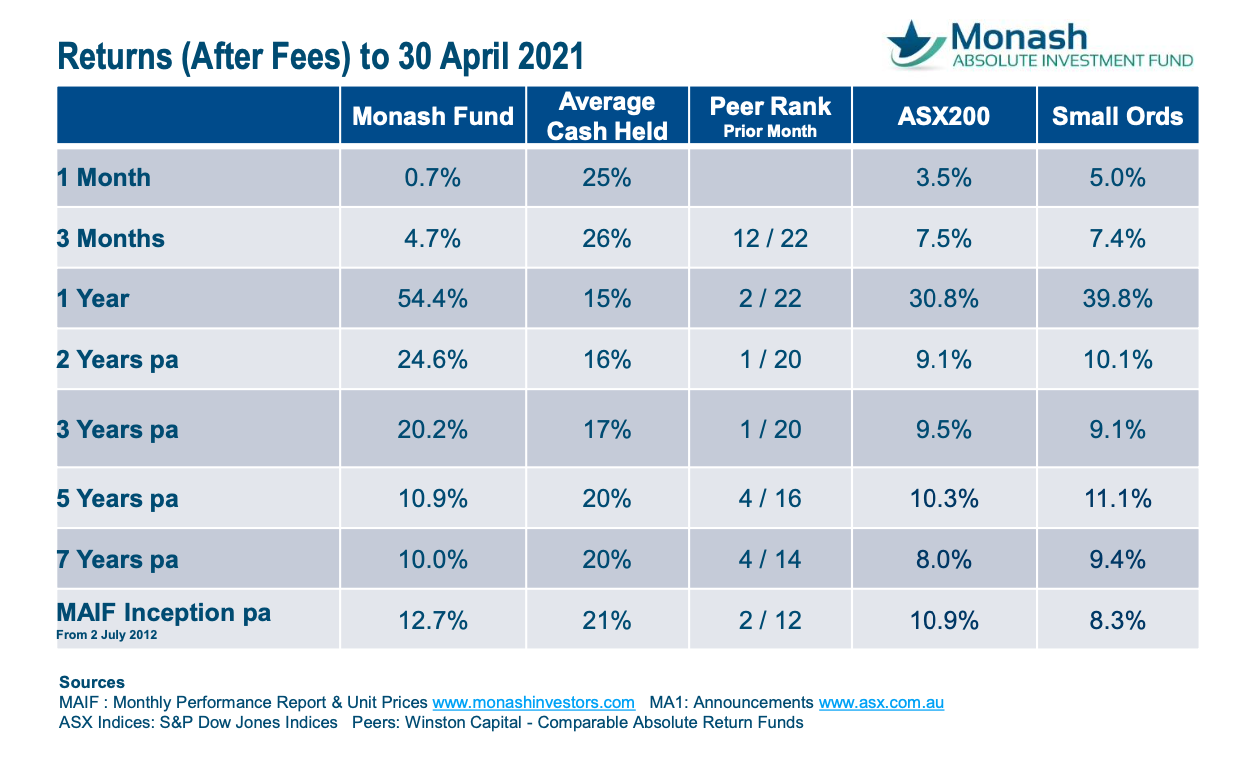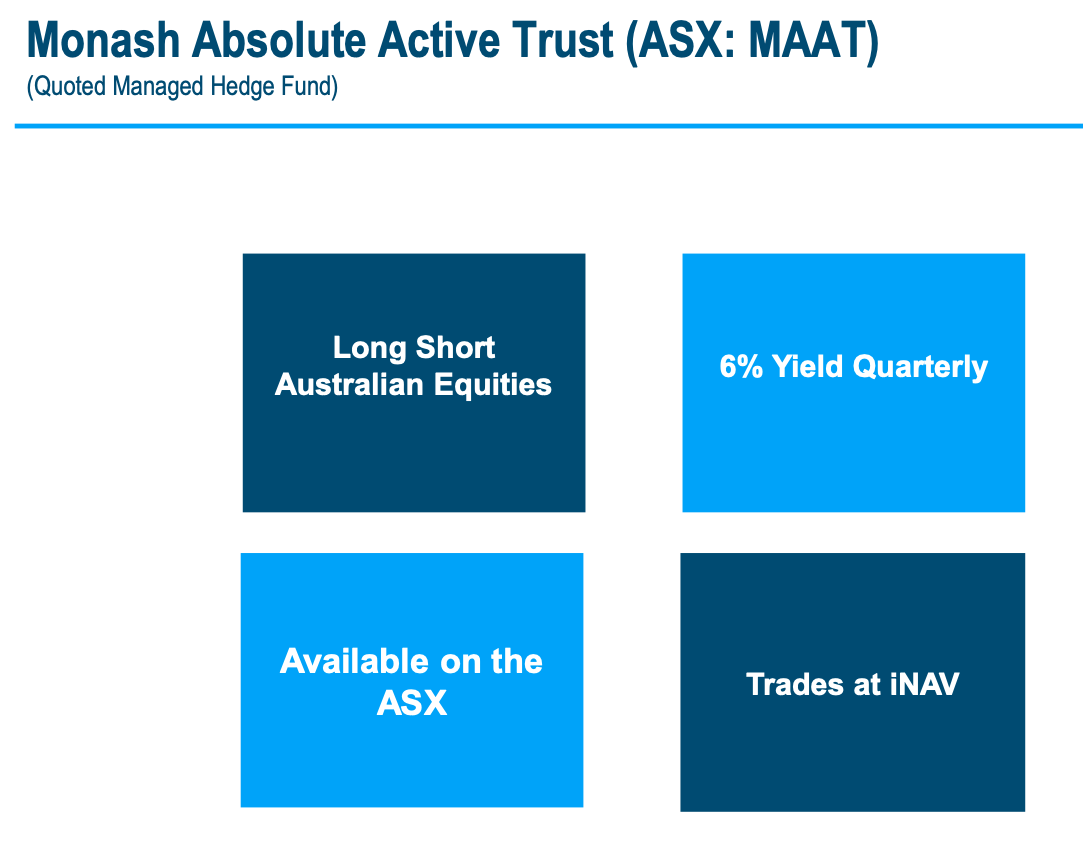Monash LIC restructure a first
The shareholders have spoken: the Monash Investors Limited Absolute Investment Company (ASX: MA1) is on track to become the first Australian listed investment company (LIC) to restructure as an exchange-traded managed fund (ETMF).
The next chapter in Monash's ASX-listed adventures kicks off on 10 June, when the new Monash Absolute Active Trust (ASX: MAAT) hits the hustings.
In the final vote held earlier this month, 99.98% of the votes cast were in favour of the shift, which should mark the end of Monash’s long-running struggle to solve some big problems for its investors. Having traded between 10% and 15% below its net tangible asset (NTA) value for years, the co-founding portfolio managers Simon Shields and Shane Fitzgerald have tried various fixes including:
- on-market buyback
- off-market buyback
- increasing the dividend payout ratio
- increasing the frequency with which the NTA was reported
- boosting its marketing spend.
“But none of these things closed up the discount. It was just completely unsatisfactory for the clients and for us,” says Shields, who recently hosted a webinar to explain the change and the features of the Monash strategy's new structure.

Thinking outside the box
The ultimate solution required the LIC's management team to do something “out of the box”. By deconstructing the LIC and turning it into a unit trust that will continue to be listed on the market, but with a market-maker, the Monash vehicle will be converted from a closed- to an open-ended product.
“There are other unit trusts out there with market-makers, but we’re the first to convert from a LIC across to an ETMF,” Shields says.
Shields and Fitzgerald insist this restructure is about putting the interests of their shareholders first. “Is this the right thing for us to do, as a fund manager? No. We’re giving up the permanent capital, but we’ve done that because we’re invested in the interests of our shareholders.”
Of course, they’re hopeful the new structure will appeal to a broader audience than the more illiquid LIC structure did, enabling them to expand the funds under management. Fitzgerald explains they’ve had numerous instances of potential investors backing away because the LIC structure didn’t provide enough liquidity for large allocations.
“For example, they’ll say, ‘How do I buy $1 million in this LIC? I can’t because it’s not liquid enough.’ So then they don’t invest in you at all,” says Fitzgerald.
“The only decision they’ve got to make now is whether they like us as a manager or not. If they like us, you’ve just got to choose how you want to access it and then you’re done.”

Source: Monash Investors
New feature: the dual registry
His point about access refers to the dual-listing of the new ETMF, which means potential investors can either buy units in the trust on-market from the ASX, or via a standard application process through a wealth management platform.
“That’s a new feature for ETMFs. Having only been available in the market for less than 12 months, not many have this feature yet,” Shields says.
What’s the difference between an ETF and an ETMF?
The main distinction is that an ETMF is a managed fund, and because Monash is a long-short manager and can charge a performance fee, it must describe the product as a hedge fund.
“But it’s a unit trust, just like any other that you can invest in, it just happens to be listed. In the same way that an unlisted unit trust is priced every day, ours also is an iNAV (net asset value) that allows the unit trust to trade at a price that goes up and down during the day, rather than having to wait until the end of the day for the final price, as you would in an unlisted unit trust,” says Shields.
“You buy and sell just as you would any other share, but rather than being at a discount like many LICs are, we’re always going to be very close to NAV and with terrific liquidity.”
What does it cost?
Of course, the price you pay for any investment plays a huge role in the returns you ultimately receive. The fee charged to investors under the ETMF structure will be 1.25% plus GST – a reduction from the 1.5% plus GST fee charged under the LIC structure of Monash Alternative Investment Fund.
The performance fee has also been altered, in line with persistently low rates.
“This is because the cash rate has fallen so much, so previously we were just looking for a performance fee above the cash rate, now we’re going to be charging the performance fee starting 5% above the cash rate," says Shields.
There is also a “high water mark” which means we don’t charge fees for performance when we’re below the previous high of the last time we charged a performance fee.”
Other key features
The ability to take short positions on stocks is another major distinction of the Monash ETMF, a feature rarely available from active ETFs. “As far as we’re aware, we’re the only one in the Australian equities market that offers a long-short ETMF.
Another major feature is a minimum 6% yield each year.
Every quarter, the ETMF will distribute at least 1.5% to investors, because as a unit trust it is required to pass on to investors all net realised income and capital gains.
For further information about how the Monash Absolute Active Trust works, its new features and an update on the portfolio positioning, you can tune in to the full webinar recording here.
Accessing the new ETMF
The Monash Absolute Active Trust (Hedge Fund) (ASX:MAAT), with will be available on the ASX on 10th June 2021 under the ASX code of MAAT. To be the first to hear updates, please fill in your details via the contact form below.
4 topics
3 contributors mentioned

